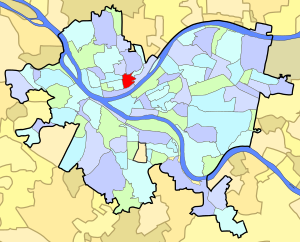East Allegheny (Pittsburgh)
| East Allegheny | |
|---|---|
| Neighborhood of Pittsburgh | |

Cedar Avenue in East Allegheny
|
|
 |
|
| Coordinates: 40°27′22″N 80°00′00″W / 40.456°N 80.000°W | |
| Country | United States |
| State | Pennsylvania |
| County | Allegheny County |
| City | Pittsburgh |
| Area | |
| • Total | 0.236 sq mi (0.61 km2) |
| Population (2010) | |
| • Total | 2,136 |
| • Density | 9,100/sq mi (3,500/km2) |
| ZIP Code | 15212 |
|
Deutschtown Historic District
|
|
| Area | Roughly bounded by Cedar Avenue, Knoll, East, and Pressley Streets |
| Architectural style | Late Victorian |
| NRHP Reference # | 83004181 |
| Significant dates | |
| Added to NRHP | November 25, 1983 |
| Designated CPHD | February 12, 1997 |
East Allegheny, also known as Deutschtown, is a neighborhood on Pittsburgh's North Side. It has a ZIP Code of 15212, and has representation on Pittsburgh City Council by the council member for District 1 (North Central Neighborhoods). The Pittsburgh Bureau of Fire houses 32 Engine and 32 Truck in Deutschtown.
In 1783, the Commonwealth of Pennsylvania established a 3000-acre tract of land north of where the Allegheny River merged with the Ohio River. John Redick created an initial town plan for Allegheny City – which featured 36 city blocks surrounded by a common grazing area – the following year. The common grazing area became a park now known as Allegheny Commons, and the area just east of the park – which had been set aside for farming in Redick's initial plan – is today's East Allegheny.
This area was developed between 1850 and 1900 by immigrants who were almost exclusively German. As a result, the area was called Dutchtown, a mispronunciation of Deutschtown. Its residents created a business district on East Ohio Street and a residential district running south of it, from Cedar Street (on the western border with Allegheny Commons) to Troy Hill (on the east). These buildings were very solidly built.
In 1984, this area was listed on the National Register of Historic Places as the Deutschtown Historic District. The nominating petition noted that "Dutchtown is distinguished from neighboring North Side neighborhoods by its ethnic associations and intense feeling of neighborhood solidarity. It also retains the busiest original commercial district left on the North Side since the development of Allegheny Center in the 1960's." The area is also a City of Pittsburgh Historic District.
Construction of Interstate 279 sliced the neighborhood in half, such that there is now a West Deutschtown (which runs from Allegheny Commons to the Interstate and contains the active business district on East Ohio Street) and an East Deutschtown (which runs from the Interstate to Troy Hill). Both sections of the neighborhood suffered as a result of the Interstate's construction: some residents moved, their homes were rented by absentee landlords to low-income tenants, and the area saw a general lack of investment. However, neighborhood activists established the East Allegheny Community Council and gradually restored the neighborhood, especially the western portion.
...
Wikipedia



